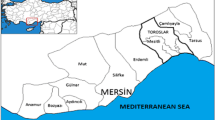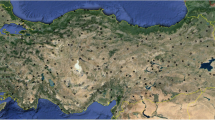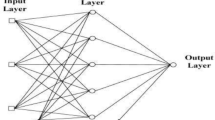Abstract
In this study, monthly soil temperature was modeled by linear regression (LR), nonlinear regression (NLR) and artificial neural network (ANN) methods. The soil temperature and other meteorological parameters, which have been taken from Adana meteorological station, were observed between the years of 2000 and 2007 by the Turkish State Meteorological Service (TSMS). The soil temperatures were measured at depths of 5, 10, 20, 50 and 100 cm below the ground level. A three-layer feed-forward ANN structure was constructed and a back-propagation algorithm was used for the training of ANNs. In order to get a successful simulation, the correlation coefficients between all of the meteorological variables (soil temperature, atmospheric temperature, atmospheric pressure, relative humidity, wind speed, rainfall, global solar radiation and sunshine duration) were calculated taking them two by two. First, all independent variables were split into two time periods such as cold and warm seasons. They were added to the enter regression model. Then, the method of stepwise multiple regression was applied for the selection of the “best” regression equation (model). Thus, the best independent variables were selected for the LR and NLR models and they were also used in the input layer of the ANN method. Results of these methods were compared to each other. Finally, the ANN method was found to provide better performance than the LR and NLR methods.









Similar content being viewed by others
References
Abdul-Wahab SA, Bakheit CS, Al-Alawi SM (2005) Principle component and multiple regression analysis in modeling of ground-level ozone and factors affecting its concentrations. Environ Model Softw 20:1263–1271
Aydin M, Yang SL, Kurt N, Yano T (2005) Test of a simple model for estimating evaporation from bare soils in different environments. Ecol Model 182:91–105
Bechrakis DA, Sparis PD (2004) Correlation of wind speed between neighboring measuring stations. IEEE Trans Energy Convers 19:400–406
Berry EC, Jordan D (2001) Temperature and soil moisture content effects on the growth of Lumbricus terrestris (Oligochaeta: Lumbricidae) under laboratory conditions. Soil Biol Biochem 33:133–136
Bilgili M, Sahin B (2010) Prediction of long-term monthly temperature and rainfall in Turkey. Energy Sources 32:60–71
Bilgili M, Sahin B, Yasar A (2007) Application of artificial neural networks for the wind speed prediction of target station using reference stations data. Renew Energy 32:2350–2360
Cankaya S (2009) A comparative study of some estimation methods for parameters and effects of outliers in simple regression model for research on small ruminants. Trop Anim Health Prod 41:35–41
Cevik A (2007) Unified formulation for web crippling strength of cold-formed steel sheeting using stepwise regression. J Constr Steel Res 63:1305–1316
Chen MM, Zhu YG, Su YH, Chen BD, Fu BJ, Marschner P (2007) Effects of soil moisture and plant interactions on the soil microbial community structure. Eur J Soil Biol 43:31–38
Dinçer İ, Acar A, Kocaoğlu A (2010) Engineering properties and dynamic behavior of caliche deposits in a seismically active region in southern Turkey. Eng Geol 111:73–89
Droulia F, Lykoudis S, Tsiros I, Alvertos N, Akylas E, Garofalakis I (2009) Ground temperature estimations using simplified analytical and semi-empirical approaches. Sol Energy 83:211–219
Enrique G, Braud I, Jean-Louis T, Michel V, Pierre B, Jean-Christophe C (1999) Modelling heat and water exchanges of fallow land covered with plant-residue mulch. Agric For Meteorol 97:151–169
Firat M, Gungor M (2009) Generalized regression neural networks and feed forward neural networks for prediction of scour depth around bridge piers. Adv Eng Softw 40:731–737
Gao Z, Bian L, Hu Y, Wang L, Fan J (2007) Determination of soil temperature in an arid region. J Arid Environ 71:157–168
Gao Z, Horton R, Wang L, Liu H, Wen J (2008) An improved force-restore method for soil temperature prediction. Eur J Soil Sci 59:972–981
García-Suárez AM, Butler CJ (2006) Soil temperatures at Armagh observatory, Northern Ireland, from 1904 to 2002. Int J Climatol 26:1075–1089
George RK (2001) Prediction of soil temperature by using artificial neural networks algorithms. Nonlinear Anal 47:1737–1748
Haykin S (1994) Neural networks, a comprehensive foundation. Prentice-Hall, Inc., New Jersey
Kalogirou SA (2001) Artificial neural networks in renewable energy systems applications: a review. Renew Sustain Energy Rev 5:373–401
Kang S, Kim S, Oh S, Lee D (2000) Predicting spatial and temporal patterns of soil temperature based on topography, surface cover and air temperature. For Ecol Manag 136:173–184
Kayadelen C (2008) The consolidation characteristics of an unsaturated compacted soil. Environ Geol 54:325–334
Kisi O (2004) River flow modeling using artificial neural networks. J Hydrol Eng 9:60–63
Koçak K, Şaylan L, Eitzinger J (2004) Nonlinear prediction of near-surface temperature via univariate and multivariate time series embedding. Ecol Model 173:1–7
Krauss G, Kindangen JI, Depecker P (1997) Using artificial neural networks to predict interior velocity coefficients. Build Environ 32:295–303
Maqsood I, Khan MR, Huang GH, Abdalla R (2005) Application of soft computing models to hourly weather analysis in southern Saskatchewan, Canada. Eng Appl Artif Intell 18:115–125
Melesse AM, Hanley RS (2005) Artificial neural network application for multi-ecosystem carbon flux simulation. Ecol Model 189:305–314
Mihalakakou G (2002) On estimating soil surface temperature profiles. Energy Build 34:251–259
Owe M, de Jeu R, Walker J (2001) A methodology for surface soil moisture and vegetation optical depth retrieval using the microwave polarization difference index. IEEE Trans Geosci Remote Sens 39:1643–1654
Özbayoğlu G, Özbayoğlu ME (2006) A new approach for the prediction of ash fusion temperatures: a case study using Turkish lignites. Fuel 85:545–552
Paul KI, Polglase PJ, Smethurst PJ, O’Connell AM, Carlyle CJ, Khanna PK (2004) Soil temperature under forests: a simple model for predicting soil temperature under a range of forest types. Agric For Meteorol 121:167–182
Prangnell J, McGowan G (2009) Soil temperature calculation for burial site analysis. Forensic Sci Int 191:104–109
Sivrikaya O, Kilic AM, Yalcin MG, Aykamis AS, Sonmez M (2008) The 2001 Adana landslide and its destructive effects, Turkey. Environ Geol 54:1489–1500
Sözen A, Arcaklıoğlu E, Özalp M, Çağlar N (2005) Forecasting based on neural network approach of solar potential in Turkey. Renew Energy 30:1075–1090
Tadono T, Shimada M, Fujii H, Kaihotsu I (2008) Estimation and validation of soil moisture using PALSAR onboard ALOS over Mongolian plateau. Piers Online 4:691–694
Tenge AJ, Kagihura FBS, Lal R, Singh BR (1998) Diurnal soil temperature fluctuations for different erosion classes of an oxisol at Mlingano, Tanzania. Soil Tillage Res 49:211–217
Weitz AM, Linder E, Frolking S, Crill PM, Keller M (2001) N2O emissions from humid tropical agricultural soils: effects of soil moisture, texture and nitrogen availability. Soil Biol Biochem 33:1077–1093
Yılmaz T, Özbek A, Yılmaz A, Büyükalaca O (2009) Influence of upper layer properties on the ground temperature distribution. J Therm Sci Technol 29:43–51
Author information
Authors and Affiliations
Corresponding author
Rights and permissions
About this article
Cite this article
Bilgili, M. Prediction of soil temperature using regression and artificial neural network models. Meteorol Atmos Phys 110, 59–70 (2010). https://doi.org/10.1007/s00703-010-0104-x
Received:
Accepted:
Published:
Issue Date:
DOI: https://doi.org/10.1007/s00703-010-0104-x




